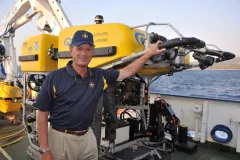Five Questions for Robert Ballard

As children, many people have dreamed of plunging beneath the ocean surface to explore the unknown world below. Dr. Robert Ballard is living his childhood dream. He is among a small number of people who can list his occupation as “Undersea Explorer.”
Since he was a teenager, Ballard has been diving and exploring the ocean using manned and unmanned submersibles. He is an ocean exploration superstar, having made some of the greatest deep-sea discoveries ever: the elusive wreck of the RMS Titanic in 1985, and a long list of other wrecks, including the battleship Bismarck. A leading expert in the use of undersea Remotely Operated Vehicles, or ROVs, he has pioneered robotic technologies that have advanced deep ocean exploration and led to phenomenal natural discoveries, including deep-sea vents, and new life-forms and geologic features worldwide. Most recently, the U.S. government sought his expertise during its response to the Deepwater Horizon disaster and the effort to stop the flow of oil 5,000 feet beneath the surface of the Gulf of Mexico.
In this National Geographic interview, Ballard offers a glimpse of his daily life, shines a light on his sources of inspiration, and explains how he got into his exciting line of work.
1. What did you want to be when you were growing up?
I wanted to be Captain Nemo and explore the world beneath the sea.
2. How did you get started in your field?
When I was 16 years old I wrote a letter to the Scripps Institution of Oceanography telling them I wanted to be an oceanographer some day and asking them what I should do. They wrote back and told me about a summer scholarship given to juniors in high school, which I was, that I could apply for. I did and received the scholarship to spend the summer at Scripps. I was further selected from a group of about 20 or so kids to go to sea on research ships. During my second cruise that summer our ship was struck by a rogue wave that almost sank the ship. I was hooked for life.
3. What is a typical day like for you?
When I am at home in Lyme I get up and do a power walk down to the Connecticut River and back, which takes about 45 minutes. I enjoy watching the forest and wetlands change over the seasons and all of the wildlife that lives around us. While walking I think about what I am going to do. Either I stay at home all day or most of the morning to work in my office and look out across the wetlands to the river, go into my office at the Institute for Exploration in Mystic to meet with my staff and plan all of the things I have do over the next several weeks, or make plans for our visitor center, or drive to my office at the Center for Ocean Exploration and Archaeological Oceanography to meet with my graduate students and research colleagues to plan the exploration plan for our new ship of the exploration the E/V Nautilus. Or I am on the road raising money to support these worlds. And if I am really lucky, I am aboard the Nautilus doing what I really love—exploring.
4. What inspires you to dedicate your life to the ocean?
I am really dedicated to understanding the planet/creature on which we live and know that means I must go beneath the sea to see 72 percent of what is going on.
5. If you could have people do one thing to help the ocean, what would it be?
I think the most important thing people can do to save our planet and the human race is to empower women! And that’s a long story!
Read the full interview with Dr. Ballard at National Geographic
Filming the Titanic: 25 years later, a team of scientists from Woods Hole Oceanographic Institution embarks on a new expedition, returning to the site of the Titanic to study the wreck and map it in high definition.
Interested in an ocean career? Learn more about Dr. Ballard’s profession and read profiles of other ocean professionals on NOAA’s ocean career webpages.

